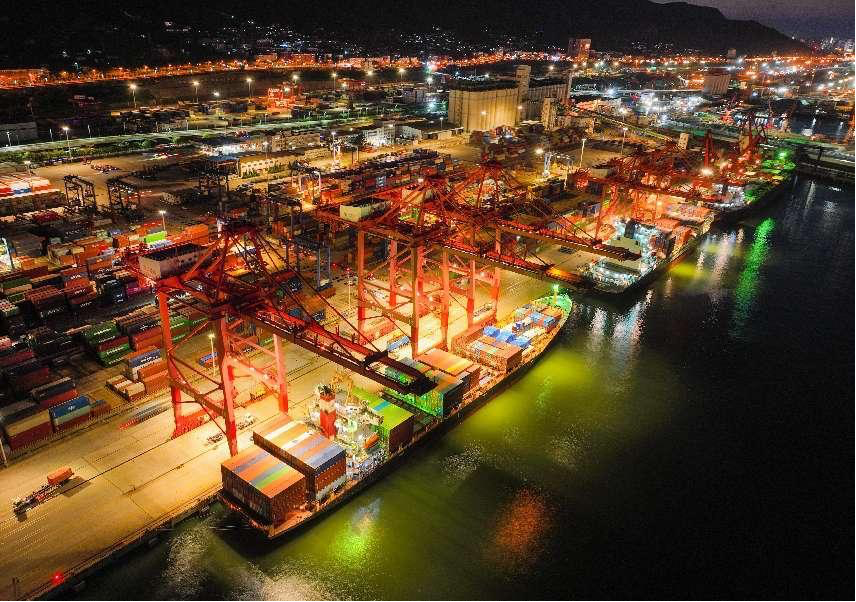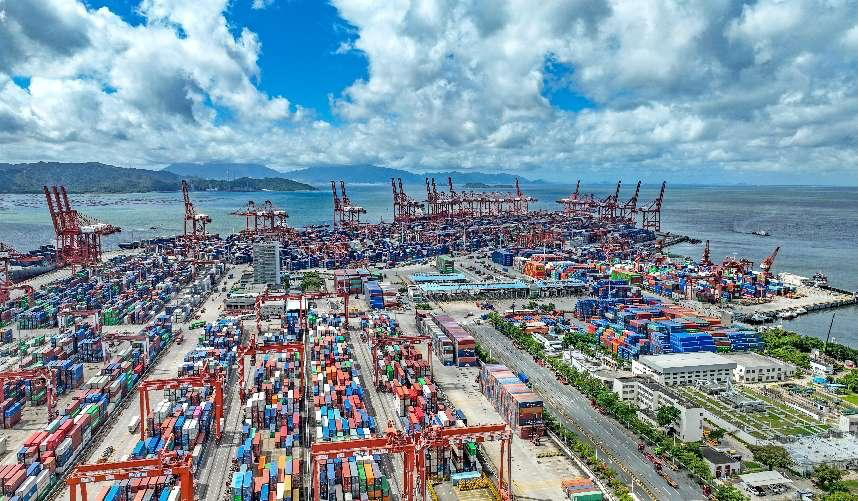Prospering ports contribute strength to China's foreign trade sector

Photo taken on Aug. 23, 2022 shows a busy scene of the Port of Qingdao in east China's Shandong province. (Photo by Hou Fangchao/People's Daily Online)
At this peak period of foreign trade, ports in China are kept very occupied. Satellite-navigated autopilot guiding vehicles are running between terminals and container yards, and gantry cranes automatically taking containers to preset destinations.
According to statistics released by the Ministry of Transport, Chinese ports handled 1.34 billion tons of cargos in July, up 5.7 percent year on year, and the country's container throughput rose 11.2 percent from a year ago to 26.36 million twenty-foot equivalent units (TEUs) during the same period.
The remarkable performance of the port industry mirrored the vitality and huge potential of the Chinese economy, especially when the country is facing an increasingly severe international situation, COVID-19 resurgences at home, and increasing downward economic pressure.

Containers are being loaded onto vessels at the Lianyungang Port, east China's Jiangsu province, Aug. 24, 2022. (Photo by Wang Jianmin/People's Daily Online)
Over 90 percent of foreign trade in China is shipped by sea, and that's why the throughputs of ports are considered one of the important economic indicators.
Since this year, China's foreign trade has been impacted by exterior environment and COVID-19 resurgences. However, the country has vitalized market entities by deepening the reform of cross-border trade facilitation, continuously optimizing business environment at ports, and implementing a series of policies stabilizing foreign trade.
The rapid development of cross-border e-commerce, the emergence of overseas warehouses and other new business models, as well as the proactive measures taken by foreign trade enterprises have also gained strong development momentums for the foreign trade sector.
The sound operation data reported by ports fully indicated the strong resilience of the foreign trade sector of China.
Industrial and supply chains are a key factor affecting the development of ports. At present, navigation channels at major ports of China are under efficient and orderly operation, delivering stable and growing operational indexes. It to a large extent comes from the safe and smooth operation of industrial and supply chains.
Since this year, relevant departments have worked to ensure smooth freight and logistics, enhanced regional synergy and coordination and substituted road transportation with water and railway transportation, to make logistics arteries smoother. As a result, ports and terminals are running stably, offering solid logistics support for foreign trade and making positive contribution to the stability of global industrial and supply chains.

Photo taken on Aug. 20, 2022 shows a busy scene of a container terminal in Shekou, Shenzhen, south China's Guangdong province. (Photo by Wang Meiyan/People's Daily Online)
The sound performance of major Chinese ports also comes from their continuously improving services and infrastructure.
As of the end of 2021, China had 20,867 operative berths, including 2,659 berths capable of handling 10,000-ton ships or even larger. World-class port clusters have taken shape in the country's Yangtze River delta, Tianjin-Hebei region, and Guangdong-Hong Kong-Macao Greater Bay Area.
So far, China has mastered key technologies for the construction and operation of automated container terminals, and currently owns the most automatic ports in the world both under construction and completed.
Relying on the large transport capacity, low cost, low pollution, small land occupation and other comparative advantages of water transportation, many ports have expanded their services to the lower and upper streams of the industrial chain and even other industries. Their proactive efforts to seek changes have improved their comprehensive service capability, and the extended industrial chain also boost the internal forces driving development and promoted the integrated development of ports, industries and cities.
Prospering ports lead to prospering trade. The high-quality development of water transport infrastructure, including ports, is of significant importance for ensuring the stability of industrial and supply chains, maintaining unimpeded domestic economic cycle and promoting the "dual circulation" development paradigm.
As China further optimizes trunk-branch connection, breaks bottlenecks of water transportation hubs and enhances the construction of sea-river joint passages, the country will see a better network of high-level waterways.
Photos
Related Stories
- China's rail-sea intermodal trains make 20,000 trips on trade corridor
- U.S.-listed Chinese firms trade mostly lower
- China issues over 2.71 mln certificates of origin from January-July
- Hong Kong's external trade records decrease in July
- U.S.-listed Chinese firms trade mostly higher
- China’s trade prowess shrugs off West’s cliché 'threat theory;' hype can’t deny China’s contributions in global supply chain
- Burgeoning service trade highlights China's opening-up endeavors in past decade
- Chinese vice premier stresses preparations for int'l services trade fair
- Deals worth over 240 bln yuan signed at Western China trade fair
- China's foreign cultural trade surges 38.7 percent in 2021
Copyright © 2022 People's Daily Online. All Rights Reserved.









